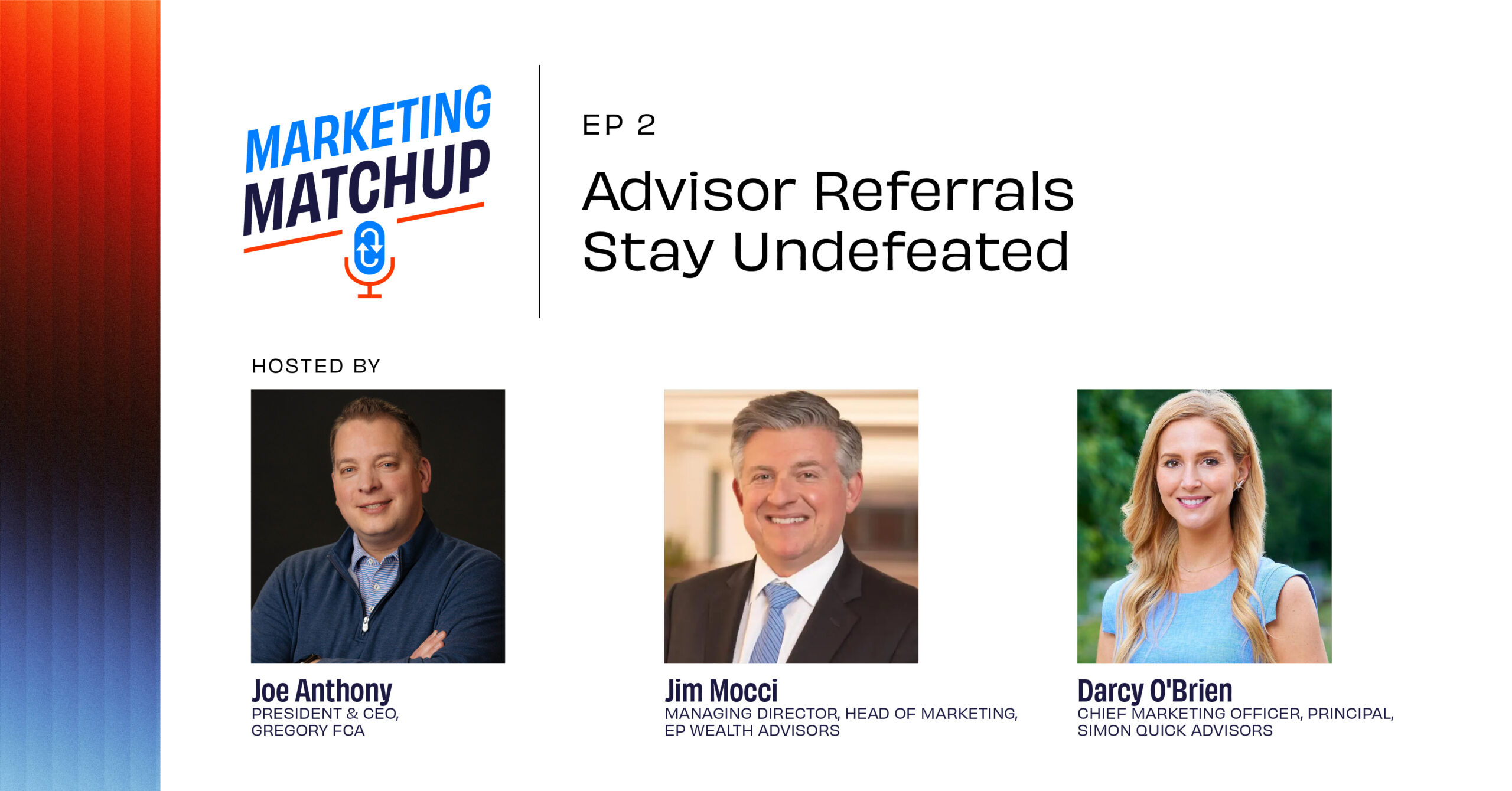You’ve built a great firm. But is your marketing keeping up with your growth goals?
Most RIAs rely on referrals and the reputations of their founders to bring in business. These are core to a firm’s growth, but after a certain point, advisors need to do more. The most successful firms know that marketing is instrumental in creating a scalable, repeatable growth engine.
In Episode 2 of Marketing Matchup, Darcy O’Brien, CMO at Simon Quick Advisors, and Jim Mocci, CMO at EP Wealth Advisors share what they have learned as their firms have built and improved on their foundational growth strategies.
Referrals Are the Best, Cheapest Business You Can Win
Client referrals are still the gold standard. Schwab’s 2024 RIA Benchmarking Study found referrals drive 67% of new business and new assets for RIAs. “This is the best, cheapest business you will ever win if you have clients out there evangelizing for you,” O’Brien said. Taking into account the time and resources spent, referrals are still one of the most cost-effective ways to generate new business.
But they don’t happen by accident. O’Brien emphasized that strong client service is the foundation of a referral-driven business. If clients aren’t thrilled with their experience, they won’t introduce the firm to others.
Still, referrals alone aren’t enough. A firm needs a structured plan to encourage and track them. Marketing plays a big role here, whether by creating shareable content, hosting exclusive events, or implementing referral incentive programs.
Mocci pointed out that marketing-generated leads require a different approach than warm client referrals. Advisors accustomed to high conversion rates from referrals might need support in nurturing and closing colder leads from other marketing efforts.
By aligning marketing and business development strategies, RIAs can build a predictable growth engine that doesn’t just rely on a handful of well-connected advisors.
Your Firm’s Legacy Can’t Be Your Whole Brand
Both Simon Quick and EP Wealth started with strong founder stories. But at a certain point, relying on an individual’s reputation isn’t enough to sustain long-term growth. The challenge for marketing leaders like O’Brien and Mocci is translating that founder-led identity into a broader, institutionalized brand.
Simon Quick’s story started when its founder, Les Quick, struggled to find a wealth manager who truly put his interests first. That experience was the genesis of the firm’s values and vision, O’Brien said. As Simon Quick has grown in size and sophistication, its story has shifted from a specific narrative centered on Les, to a strong, tangible narrative about how the firm’s entire team upholds those values.
At EP Wealth, founders Derek Holman and Brian Parker built their firm around the idea of putting clients first. That core ethos remains, Mocci said, and now their work is to operationalize EP Wealth’s growth. In other words, turning that ethos into an engine that scales.
Organic Growth Starts with Data-Driven Marketing
The firms achieving double-digit growth are doing more than waiting for referrals or hoping market performance drives AUM higher. They’re investing in marketing strategies with clear ROI.
Mocci’s team at EP Wealth tracks everything, from cost per lead to cost per million in net new assets, to link marketing investments with measurable returns. “You have to make bets,” he says, “and then measure if those bets pay off.”
At Simon Quick, O’Brien has built a lead generation dashboard in Salesforce that tracks every stage of the funnel. Instead of just focusing on brand visibility, her team is accountable for real business results, tracking how many leads convert into clients and adjusting strategies accordingly.
The Best RIAs Treat Marketing Like a Growth Driver, Not a Cost Center
Both O’Brien and Mocci credit leadership buy-in as one of the biggest catalysts of growth through a deliberate marketing process. There is a way of looking at marketing, they said, as an afterthought to fund only after every other business need is met. The most successful firms treat marketing as something that is just as vital to the business as the RIA’s tech stack or custodial partners.
EP Wealth ties its marketing budget directly to growth goals, instead of a fixed percentage of the prior year’s revenue. The firm sets a net new asset target for the year, and marketing gets a budget based on what it takes to hit that target. That shift in mindset—from “how much can we afford to spend?” to “how much should we invest to grow?”—is a game changer, Mocci said.
O’Brien has focused on advocating for the importance of marketing and welcoming the entire team into the process. Simon Quick’s 2025 marketing plan involves everyone at the RIA, linking it with the firm’s client experience and growth goals, turning marketing into something every team member understands and supports.
Watch the full conversation below, or listen to Marketing Matchup wherever you get your podcasts.
Recommend a guest
Gregory FCA invites individuals with unique insights into financial services marketing to join the conversation. Interested participants are encouraged to appear as guests. Fill out the form below to recommend someone who may be a good fit.

